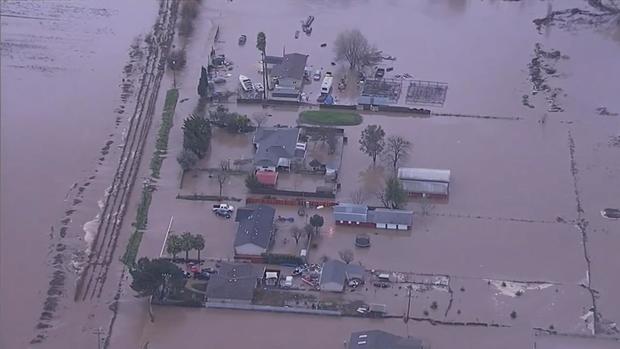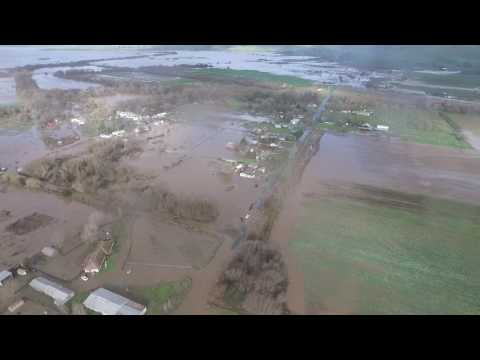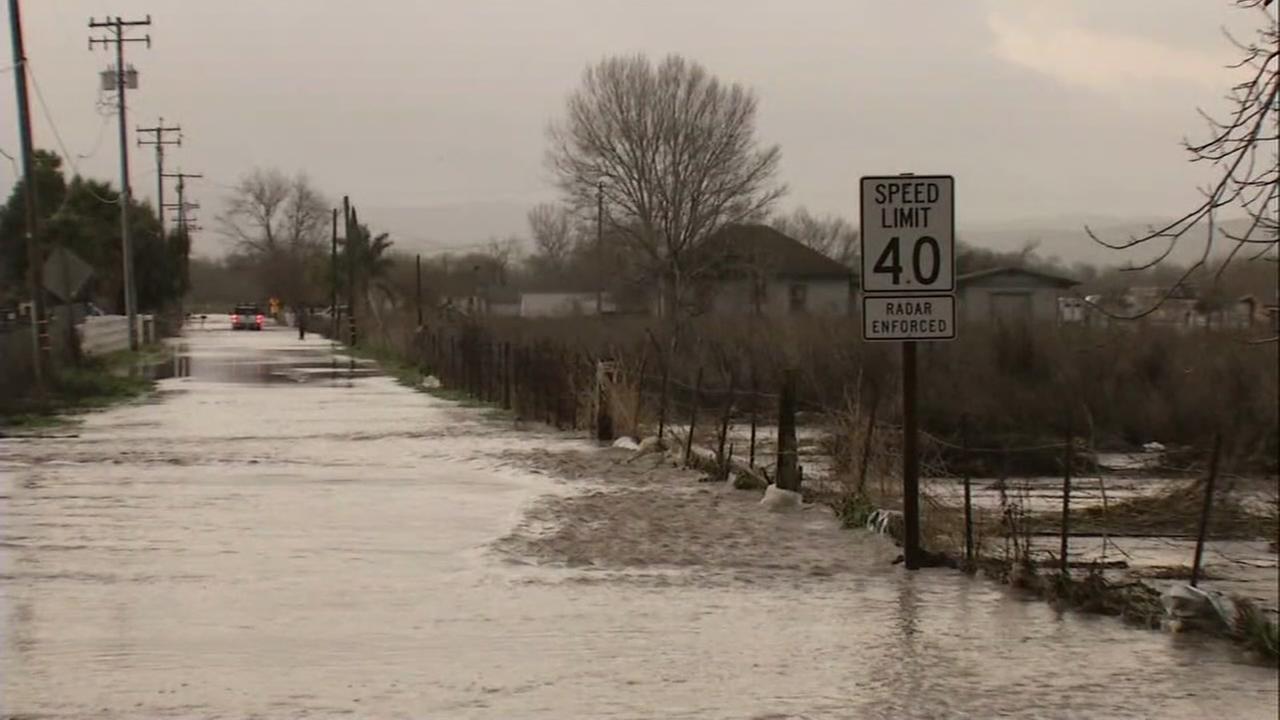My heart ached and I cried bitterly, both because we had lost one of our finest does, and because there was absolutely nothing we could have done about it.
I thought this was the worst blow we could be dealt, but I was wrong. This was before the floods, a joyous, sun-filled winter.
On February 21st, the real flood came. Surging forth from a crumbling levee miles away, it swept over San Felipe Road, through our neighbor's houses and past us. I ran out to call in the stragglers, the goats and pigs who thought they had already found higher ground. Here they are, running through the water toward the barn. An hour later, the water was another foot higher.
Our house and yard are built up several feet above the surrounding lands and were untouched.. It was a small island of land in a vast lake. We were dry, warm and had a safe haven in the yard for the bottle babies.
All of our neighbors, however, sufffered significant flood damage and all of the homes and farms to the north of us were evacuated. I am so very, very grateful, for it could have been much worse. Surely we were done with the Fates cruel trials now?
Below, the water levels some ten days after the flash flood. The field is strewn with branches and detritus - the fence on the west side of the property was swept away.
The constantly fluctuating weather and disease carried by wet, flowing miasma over more than two months exacted a heavy toll through disease. We suffered numerous losses across the age spectrum (though mainly in kids), due to pneumonia, pinkeye, giardia and frequently recurring coccidiosis. We worked with our veterinarians, but the pathogens simply could not be avoided, not without moving to a new property entirely, and that we could not do.
In all, we lost nine adult goats and over half of our kid crop. Yes, OVER HALF. I cried every morning and had to force myself to do chores, certain that yet another goat would be lying in a quiet heap in a corner, often with no previous overt signs of illness. Not going out would mean that I was not treating them as best I could, but it was all I could do to go. Meanwhile, the pathogens continued to swirl, thrive and infect our animals repeatedly as the water mingled with mucky ooze with each rainfall.
Pinkeye infections were rampant and very, very fast developing, from a slightly runny eye to fully clouded over within a day. It was the easiest disease of the floods to get under control, as it is sensitive to simple antibiotics. Yoot, below, could barely see out of this eye, but her vision has been entirely restored in the weeks after treatment.
To this day, I wake up in a cold sweat and dread going out to the barns in the morning. It has taken me this long to write about it, because I break down every time I allow myself to dwell on all the losses we endured together this year. Looking at the many happy goat pictures of the past, I am wounded to see so many that we will never watch grazing in the pasture again.
I was broken. I am still broken.
All we can do is carry on, and I consoled myself in caring for the animals that lived. Thank you to Patrice Sartor, who took many of these pictures, and without whom I could not have managed to get through the floods and aftermath. You are a true friend and undaunted by the worst parts of farming that you have witnessed this year. Thank you for your unrelenting and positive support, my dear friend. Eric was the source of unlimited hugs every time I came in sobbing, and fully supported the insane veterinary expenditure we racked up.
Below, does grazing before yet more rainfall. Shallow, infected ponds can be seen to the left. There was no way to prevent the goats from drinking from them, repeatedly, aside from locking them all up in damp, equally risky barns where they'd be in much closer quarters for transmitting disease back and forth.
Years of breeding, testing and care were decimated by a disease I had fought so hard to avoid since I got back into goats in 2010: caseous lymphadenitis. I'll document our CL saga in a separate series of evolving blog posts.
The flood waters are gone, the remaining goats are doing well, life is slowly returning to normal... and we are taking firm control of our CL situation with a solid plan for management and eradication, in conjunction with our vet clinic. Our goat herd is CLOSED to all sales and breeding until such time as we resolve this herd health issue. It's going to be a long while.
I will never forget this year, the war on water, in a region so drought-stricken. Irony and tragedy, lightened by the support of true friends, innumerable hugs and kind words from our fellow goat breeders.
I am glad that I did not give up, and I am resolved: we will recover.
Linda
Mythos Farm
ps. We did NOT have the worst of it, and it makes me braver to see how well others faced their own tragedies. Again, our home and two of three barns were spared - most were not. Below, some images from the surrounding farms and homes in January and February. The lady leading the horse to safety is our neighbor Julie Carriero, who as the Animal Control Officer at the time - she later had to evacuate her own farm with her entire herd of prize-winning Boers.
















 RSS Feed
RSS Feed